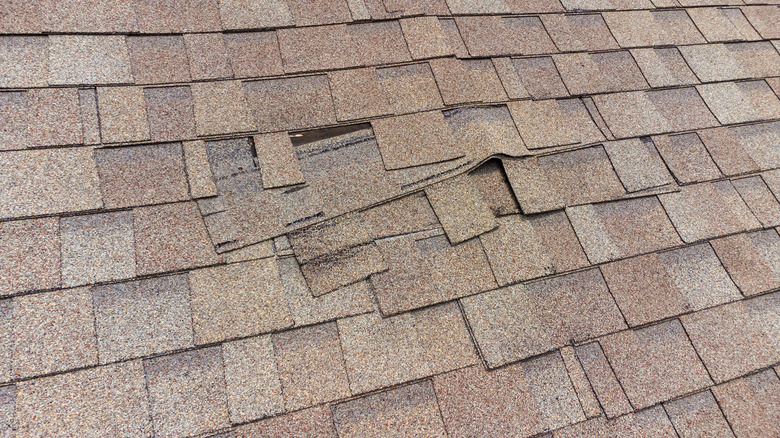How To Fix A Hole In The Roof
We may receive a commission on purchases made from links.
Perhaps high winds blew a tree branch onto your roof with enough force to make a hole, or perhaps you made a hole yourself when you removed an old satellite dish or antenna. Whatever the reason for the hole, it has to be fixed posthaste, or you'll have a nasty situation in the attic the next time it rains, not to mention that a sizable hole is an invitation for small animals and birds to enter the attic.
This is a job you can DIY if you have basic carpentry skills, but you'll be working on the roof, and that's a hazard in its own right. Don't attempt this repair yourself if the roof is icy or very steep. The Occupational Safety and Health Administration defines a steep roof as any roof with a slope exceeding a pitch of 4:12, which means it rises 4 inches for every foot of horizontal distance. That's a workable slope for anyone with the right equipment doing the job in good weather, but holes in roofs with slopes much greater than that should be repaired by professionals, especially in wet or icy weather.
Things Needed
-
Ropes
-
Hooks
-
Rubber-sole shoes
-
2x4 lumber
-
2-inch exterior screws
-
5/8-inch plywood
-
Tape measure
-
1 5/8-inch exterior screws
-
1-inch roofing nails
-
Shingles
How to Fix a Hole in a Roof
1. Find the Hole
Set up a ladder on the side of the house and stabilize it by securing it to the fascia with ropes and hooks. Screw a 1/2-inch eye hook into the fascia on either side of the ladder and tie the ladder on each side. Wearing rubber-sole shoes, climb on the roof and look for the hole. If it isn't obvious, look in the attic for signs of water, such as damp insulation or water marks on the roof decking, and mark the hole by driving a screw through the decking so you can see it from the roof.
2. Remove the Shingles
Use a pry bar to remove shingles, beginning above the hole and working your way down. If any part of the roof decking is water damaged, keep removing shingles until you come to undamaged decking. Remove enough shingles to create a 6-inch border of uncovered decking around the hole. Using a claw hammer, pull out any nails that didn't come out when you removed the shingles.
3. Cut Out the Damaged Decking
Using a reciprocating saw, cut out a rectangular section of decking that completely encloses the damaged area. If the damaged decking intersects a roof rafter, cut out the decking in two sections to avoid cutting through the joist. You can also do this job with a circular saw set to a cutting depth of 3/4 inch. Because a shallow cut like that won't damage a joist, you can cut out the entire section in one piece with this method.
4. Frame the Opening
Cut lengths of 2x4 lumber to frame the top, bottom, and sides of the opening. Screw the top and bottom frames to the roof rafters on either side of the hole using 2-inch exterior screws and then screw the sides of the frame to the top and bottom. Make sure the edges of the hole bisect the top edges of the frame by about half to provide a surface on which to screw the decking patch.
5. Install the Decking Patch
Measure the thickness of the decking (most roof decking is 5/8-inch plywood), measure the dimensions of the opening, and cut a piece of identical plywood to your measurements. Lay a bead of construction adhesive on the top edge of the frame, fit the patch into the hole, and secure it with 1 5/8-inch exterior screws.
6. Lay Tar Paper
Fill the gaps around the edges of the patch with roofing tar and then lay tar paper over the hole. Make sure the tar paper extends under the top row of shingles and extends all the way to the sides and bottom of the uncovered decking. Nail it down with 1-inch roofing nails.
7. Install Shingles
Start laying shingles at the bottom of the patch and work your way toward the top. Nail the shingles to the roof decking with 1-inch roofing nails and put a dab of roofing tar over the head of each nail to keep out water.
